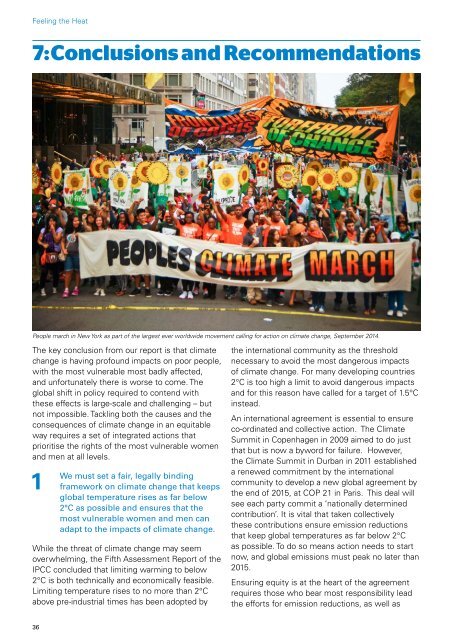trocaire-climate-change-report-2014
trocaire-climate-change-report-2014
trocaire-climate-change-report-2014
Create successful ePaper yourself
Turn your PDF publications into a flip-book with our unique Google optimized e-Paper software.
Feeling the Heat<br />
7: Conclusions and Recommendations<br />
People march in New York as part of the largest ever worldwide movement calling for action on <strong>climate</strong> <strong>change</strong>, September <strong>2014</strong>.<br />
The key conclusion from our <strong>report</strong> is that <strong>climate</strong><br />
<strong>change</strong> is having profound impacts on poor people,<br />
with the most vulnerable most badly affected,<br />
and unfortunately there is worse to come. The<br />
global shift in policy required to contend with<br />
these effects is large-scale and challenging – but<br />
not impossible. Tackling both the causes and the<br />
consequences of <strong>climate</strong> <strong>change</strong> in an equitable<br />
way requires a set of integrated actions that<br />
prioritise the rights of the most vulnerable women<br />
and men at all levels.<br />
1<br />
We<br />
must set a fair, legally binding<br />
framework on <strong>climate</strong> <strong>change</strong> that keeps<br />
global temperature rises as far below<br />
2°C as possible and ensures that the<br />
most vulnerable women and men can<br />
adapt to the impacts of <strong>climate</strong> <strong>change</strong>.<br />
While the threat of <strong>climate</strong> <strong>change</strong> may seem<br />
overwhelming, the Fifth Assessment Report of the<br />
IPCC concluded that limiting warming to below<br />
2°C is both technically and economically feasible.<br />
Limiting temperature rises to no more than 2°C<br />
above pre-industrial times has been adopted by<br />
the international community as the threshold<br />
necessary to avoid the most dangerous impacts<br />
of <strong>climate</strong> <strong>change</strong>. For many developing countries<br />
2°C is too high a limit to avoid dangerous impacts<br />
and for this reason have called for a target of 1.5°C<br />
instead.<br />
An international agreement is essential to ensure<br />
co-ordinated and collective action. The Climate<br />
Summit in Copenhagen in 2009 aimed to do just<br />
that but is now a byword for failure. However,<br />
the Climate Summit in Durban in 2011 established<br />
a renewed commitment by the international<br />
community to develop a new global agreement by<br />
the end of 2015, at COP 21 in Paris. This deal will<br />
see each party commit a ‘nationally determined<br />
contribution’. It is vital that taken collectively<br />
these contributions ensure emission reductions<br />
that keep global temperatures as far below 2°C<br />
as possible. To do so means action needs to start<br />
now, and global emissions must peak no later than<br />
2015.<br />
Ensuring equity is at the heart of the agreement<br />
requires those who bear most responsibility lead<br />
the efforts for emission reductions, as well as<br />
36


